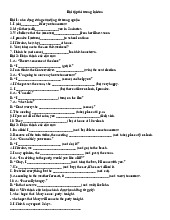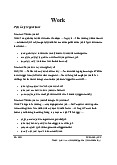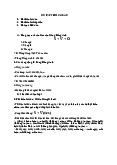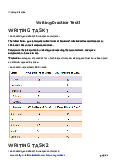













Preview text:
Unit 2: COMPETITIONS - Further Practice 2 PART 1: LISTENING
Activity 1: (audio: Activity 1&2)
https://drive.google.com/open?id=1vJUvqy0t6QC64P6- YlQ42WncEiOCQxXi Part 1 Questions 1-7
There are seven questions in this part.
For each question, there are three pictures and a short recording.
Choose the correct picture and blacken your choice on your answer sheet.
Example: What did the boy use to wear to school? A B C 1 What does the woman need? A B C
2 What time is the girl’s appointment? A B C
3 What did the man have to eat in the restaurant? A B C
4 What kind of fruit does the girl decide to buy? A B C 5 What has the man had done? A B C
6. What is the woman complaining about ? A B C
7 What does the boy want to borrow?
Activity 2: (audio: Activity 1&2)
https://drive.google.com/open?id=1vJUvqy0t6QC64P6- YlQ42WncEiOCQxXi Part 2 Questions 8-13
You wil hear a man cal ed Neil Curran talking about wildlife programmes on
television. For each question, blacken your choice on your answer sheet. 8
What time can you see Wildlife o A. at 6 pm Three today? B. at 6.45 pm C. 7.30 pm 9
Tomorrow’s programme on Indian A. unusual wildlife is mainly about B. insects and birds. C. large animals.
10 Desert Watch describes plants th A. get water from the air.
B. die when it doesn’t rain. C. grow close to rivers.
11 What is the problem on the island
A. There are few rabbits left.
B. There aren’t enough plants
C. Cats are attacking the birds.
12 What is the plan for the coast?
A. to let the water partly cover th land
B. to encourage birds to leave t area
C. to prevent sea water flooding th land 13 Why, according to Neil, are
A. They always have a lot of variety
wildlife programmes so popular?
B. People of different ages can enj them.
C. They are on quite early in th evening.
Activity 3: (audio: New Sport Center mp3)
https://drive.google.com/open?id=1mPaaR7SZEmPBlqD66sFePs1Y0QAn8Qh R
You wil hear a woman talking on the radio about a new sports centre. NEW SPORTS CENTRE 1. (A) 12th of May (B) 22nd of May
The new sports centre opens on 2. (A) supermarket (B) station (1)_______ (C) hotel
The new sports centre is opposite the3. (A) Fostescue (B) Fortrescue (2)_______ 4. (A) 19.50 (B) 9.50
The car park entrance is in (3)______5. (A) towel (B) pair of Road. shoes (C) bottle of water
It costs £(4)_______ per week to be a6. (A) yoga (B) Judo member. 7. (A) bul etin (B) website A (5)_______ is provided.
You can learn to (6 )_______ at 5.30 each day.
You can check on the (7)_______ to get more information. Activity 4: (Audio: 6210ed7f)
https://drive.google.com/open?id=1_iu8n29xlsGVEyGEjlidV5PaWrFFmAMk
There are seven questions in this part. You wil hear a woman talking on the radio
about a competition. For each question, click on the A, B or C to fil the missing
information in the numbered space. This month’s competition
Prize: a computer + a (1)…………………. Printer Write a story
Length: fewer than (2) ………………… words
Subject: a short (3)……….………. which takes place in (4) ………………..
Write your name, (5) ……………….. , telephone number and (6)……………….. at the end.
Story must arrive on or before (7)……………….. 1. A. good B. colour C. modern 2. A. 15,000 B. 1,500 C. 150 3. A. right B. flight C. crime 4. A. the past B. the present C. the future 5. A. nickname B. hobbies C. address 6. A. town B. age C. office 7. A. 8th B. 18th C. 28th PART 2: READING
Activity 1: Try to recal your knowledge and vocabulary about the development of badminton
Activity 2: (Life Pre WB/ P112)
Read the fol owing article and do the exercise below THE HISTORY OF BADMINTON Badminton is a ra quầ cq n vợ u
t et sport in which two or four players hit an obje cal ed a shu quảtt clầe co u lông ck back quay ng w ượ a
c rds and forwards across a high net. So people regard
coi/chú ý it as the oldest racquet sport in the world, although th earliest forms of the sport p
có lẽ robably didn't use a racquet, and the ne re t lươati ng vđốeily rgeầc n đ en ây t in sự nđo ổ v i m a
ới tion. A shuttle cock is a nhliẹghtweight bal made cor nút b kần, with feath lông vũers a
gắ tntached to it to help it fly. It is thought that shutt
cocks were first used about 2,500 years ago in China - although the were k
đ iácked rather than being hit with a racquet in those days. A rac
sport using shuttlecocks was certainly known ciổn x ưa a ncient Greece aro
2,000 years ago, as wel as in China and Japan, and a version of th
game has been played by children across Asia for ever since. The a
was to keep hitting the shuttlecock backwards and forwards for as l
as possible. The modern game we cal badminton was developed in
England, however, and not until the 19th century. British soldiers lea
to play a game using shuttlecocks whilst serving in India from the
middle of the 18th century onwards. When they came home, they
brought the game with them. At this point, it was cal ed Poona - nam
after a place in India - and from about 1860, it became popular in
England. That's where a net was first introduced in 1867, and the
modern system of scoring began to evolve, although there were lots
disagreements about the rules amongst the players, and no official
organisation to govern the sport. Al this changed in 1887. The nam
'badminton' was introduced after a famous party at a country house
that name in that year. At the party, a game was played that was ve
similar to the one we cal badminton today. A set of modern rules w
drawn up and published in 1893, and the Badminton Association of
England was formed in 1895 to govern the new sport and organise
championships. The first of these were held in 1899 and 1900, for m
and women respectively. Badminton can be played by both men an
women, although slightly different rules and scoring systems apply.
The new sport soon became very popular in England. By 1920, the
were 300 badminton clubs in the country, and that figure had risen
500 by 1930. At the same time, the sport was catching on in other
countries too, and in 1934 an International Badminton Federation (I
was set up. The IBF decided to run international championships in
but because of the second world war, the first one didn't take place
1948, and then only for men. The first international women's
championships were held in 1957. Badminton was first played at th
Olympic Games in 1972, but only as a demonstration sport - there w
no actual competition and no medal winners. Although this happene
again in 1988, it was 1992 before badminton was played as a ful y
recognised Olympic sport - with the mixed doubles being added in
Badminton is now one of the most widely played sports in the world
is one of the fastest racquet sports, with shuttlecocks travel ing at u
260 miles per hour in top competitions, and so is very exciting to wa as wel as play.
Decide if the statements are true (T) or false (F)
1.Women's badminton has the same rules as men's badminton
2. Men and women can play against each other in the Olympic games.
3. The badminton net was first used in India.
4. The modern game was first played at Badminton House in England in 1887.
5. In 1893 the first written rules for the game cal ed badminton became available.
6. A national badminton organisation was formed in 1995 in England .
7. The first men's national championships were held in Japan.
8. An international badminton organisation was formed in 1934.
9. People in China used to kick shuttlecocks to each other.
10. The shuttlecock was invented in Greece.
Activity 3: Read the text below and choose the best answer ANN JONES
I want to tel you about Anna Jones. I think that she is one of the ___A_
interesting people I have ever met. She is only twenty-five, but is already a
known travel er. Ann has travel ed to a large _______(21) of foreign countries
first _______(22) Ann went abroad was seven years ago, when she was just eig
It was not an easy journey. She _______(23) a boat from England to France a
travel ed around Europe for five weeks. Since that first trip Ann has ______
Europe many times. But she wil never _______(25) the excitement of thos
weeks. Ann’s journeys were not always enjoyable. Once, for example, when Ann was
on a train, someone _______(26) her purse and she had to work in a restaura
fortnight to earn _______(27) money. But she made some good friends while s
there and stil keeps this experience as a good memory. How does Ann
_______(28) the money for travel ing? For her first trip abroad, she had
_______(29 money for two years. But nowadays she finds jobs and earns some _______(30) her trips.
She has never thought of giving up her travels. ‘The exceptional experience I had on
that first trip abroad many years ago has changed my life, and I've wanted to
ever since,’ Ann Jones says. 21 A part B number C many D lots 22 A thing B country C time D moment 23 A took B take C taken D taking 24 A gone B arrived C visited D come 25 A remember B f orget C remind D return 26 A robbed B gave C brought D stole 27 A some B any C many D a lot 28 A look B look at C find D found 29 A saved B saving C save D saves 30 A when B whenever C while D during PART 3: WRITING
Activity 1: Complete the second sentence so that it means the same as the first one.
1. I couldn’t win despite training very hard.
Though ………………………………………………
2. Despite the traffic, I arrived at the race on time.
Although …………………………………………….
3. Despite her good qualifications, she didn’t get the first prize.
Though ………………………………………………
4. It’s very comfortable to watch football match on TV at home.
I find it ………………………………………....
5. It’s unpleasant for them to be trained in such a noisy place.
They ……………………………………………………
6. It’s dangerous for people to ride a motorcycle without wearing a helmet.
People ………………………………………………..
7. It’s very important for players to follow the rules.
Players ………………………………………………
8. My sister watches more basebal competitions on TV than me.
I don’t watch ……………………………… as my sister does.
9. I was given some information about a local boat-race by the people there.
The people there………………… some information about a local boat-race. Activity 2:
Your pen-friend Davis is going to visit your hometown and ask if he can attend any
traditional race/ competition there or not.
Write an email to him. In your email, you should tel him something about your
traditional boat- race of Thua- Thien Hue province
1. How often is the race? & How old do the spectators have to be to enter?
2. What do the spectators have to bring to join? & What kind of clothes do they have to wear?
3. What is the prize for the winner? Write about 35-45 words. PART 4: SPEAKING Part 1: Talk about yourself:
1. Do you like playing any kinds of sport?
2. Do you like playing footbal or watching it? Why?
3. What types of sports are popular in your country?
4. What are the benefits of playing a sport?
5. Do you think the types of sport that are popular wil change in the future?
6. How can sports bring people from different countries closer together?
7. What are the advantages of hosting different international sporting events in a country?
8. How can we encourage children to participate in different types of sporting activities?
Part 2: Describing your favorite sport/ race
(Present your topic based on the fol owing questions)
1. What is the name of the sport/ race? 2. When do you play it?
3. How do you feel after playing it?
4. And explain why do you like it? Part 3: Further discussion
1. How important are sport and sports people in your country?
2. Do any of them look like or behave like pop or film stars?




